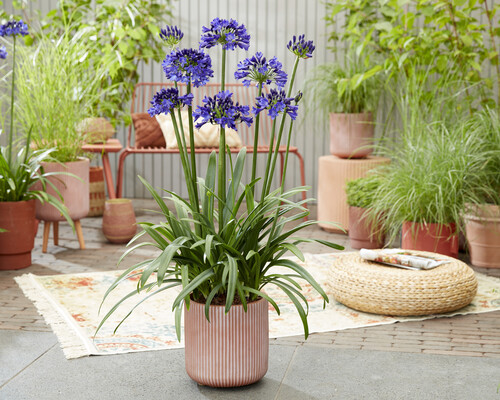Agapanthus Proliferation: Tips for Expanding Your Plant Collection
Agapanthus Proliferation: Tips for Expanding Your Plant Collection
Blog Article
Understanding the Art of Agapanthus Care: Necessary Actions for Healthy Growth and Vivid Blooms
In the realm of cultivation, the farming of agapanthus stands as a satisfying undertaking for those who look for to support these sophisticated flowering plants. From choosing the best variety to mastering pruning techniques, the trip in the direction of growing growing agapanthus plants is diverse and holds the essential to opening the full capacity of these herb gems.

Selecting the Right Agapanthus Range

When choosing the ideal Agapanthus variety for your yard, think about factors such as environment viability, bloom shade, and development habit. Agapanthus, frequently understood as Lily of the Nile or African lily, is available in a range of shades varying from shades of blue and purple to white. Pick a bloom shade that enhances your existing garden palette to develop an unified landscape. Additionally, take into consideration the environment in your area to make certain the Agapanthus variety you choose can grow in your certain problems. Some varieties are much more tolerant of cool temperature levels, while others choose warmer environments. Recognizing the growth practice of various Agapanthus varieties is crucial for correct positioning within your garden. Some selections have a clumping growth routine, perfect for boundaries or containers, while others have a more spreading nature, ideal for ground cover or mass plantings. By thoroughly assessing these elements, you can pick the best Agapanthus variety to boost the beauty of your garden.
Ideal Growing Problems
Considering the optimal environmental demands is crucial for successful Agapanthus cultivation. Agapanthus grows in well-draining soil with a slightly acidic to neutral pH degree. When growing, choose an area that gets complete sunlight to partial color. In hotter environments, offering some mid-day color can protect against scorching of the fallen leaves. Agapanthus plants are delicate to cool temperature levels and ought to be protected from frost throughout winter season.
To guarantee healthy and balanced growth and dynamic blooms, plant Agapanthus light bulbs at a depth of regarding 2-4 inches and area them 8-12 inches apart. Mulching around the base of the plants helps retain dampness and reduces weed growth.
Watering and Fertilizing Tips
Maintaining appropriate moisture levels and offering important nutrients are vital aspects in the treatment regimen for Agapanthus plants. When it comes to watering Agapanthus, it is critical to strike an equilibrium. These plants prefer regularly damp dirt but are prone to root rot if overwatered.
Feeding Agapanthus is vital for promoting healthy development and prolific flowers. Apply a balanced fertilizer, such as a 10-10-10 formula, in the early spring as brand-new development arises. Repeat this application every 6-8 weeks throughout the expanding period. Avoid too much fertilizing, as it can cause lavish foliage at the expenditure of blooms. Always comply with the supplier's guidelines for correct dilution and application methods. By complying with these watering and feeding pointers, you can guarantee your Agapanthus plants prosper and generate dynamic, durable blossoms.
Trimming Techniques for Agapanthus
Trimming Agapanthus directory plants at the suitable times and with proper strategies is essential for maintaining their health and promoting optimum development and blooming. The perfect time to trim Agapanthus is in This Site late winter season or very early spring prior to new growth arises.
Deadheading spent blossoms can also reroute the plant's power right into producing more blossoms rather than establishing seeds. If you desire to gather seeds for proliferation, leave some blossoms to mature and completely dry on the plant.
Remember to use clean, sharp devices to make exact cuts and decrease the risk of introducing conditions. Agapanthus. Routine trimming will certainly help maintain your Agapanthus looking healthy and balanced and cool while guaranteeing a bountiful display screen of gorgeous blossoms
Handling Usual Bugs and Illness
After making certain appropriate pruning methods for Agapanthus, it is crucial to attend to typical bugs and conditions that can influence the wellness and vigor of these plants. One common bug that influences Agapanthus is the Agapanthus gall midge.
Furthermore, Agapanthus plants can experience from origin rot if they are planted in poorly draining dirt. By being cautious and taking punctual activity against illness and pests, you can help your Agapanthus plants thrive and produce vivid blossoms. Agapanthus.

Verdict
In final thought, mastering the art of agapanthus treatment involves picking the best range, providing excellent planting problems, correct watering and click to read more fertilizing, suitable trimming methods, and dealing with common insects and conditions. By complying with these necessary steps, you can make sure healthy development and vivid flowers for your agapanthus plants. Keep in mind to consistently keep an eye on and preserve your plants to advertise their overall wellness and longevity.
To ensure healthy development and vibrant flowers, plant Agapanthus light bulbs at a deepness of regarding 2-4 inches and room them 8-12 inches apart. By following these watering and feeding pointers, you can guarantee your Agapanthus plants grow and generate dynamic, long-lasting flowers.
One typical pest that affects Agapanthus is the Agapanthus gall midge. In addition, Agapanthus plants can endure from origin rot if they are planted in inadequately draining pipes soil. By following these essential actions, you can guarantee healthy growth and dynamic blooms for your agapanthus plants.
Report this page